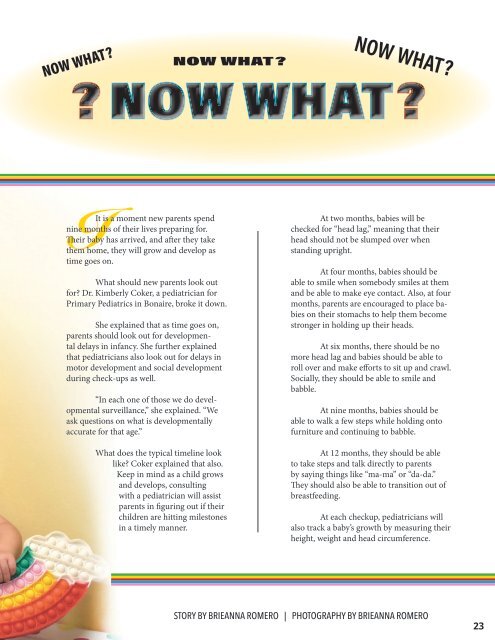Fall Health and Wellness 2022
Create successful ePaper yourself
Turn your PDF publications into a flip-book with our unique Google optimized e-Paper software.
NOW WHAT?<br />
NOW WHAT?<br />
NOW WHAT?<br />
It is a moment new parents spend<br />
nine months of their lives preparing for.<br />
Their baby has arrived, <strong>and</strong> after they take<br />
them home, they will grow <strong>and</strong> develop as<br />
time goes on.<br />
What should new parents look out<br />
for? Dr. Kimberly Coker, a pediatrician for<br />
Primary Pediatrics in Bonaire, broke it down.<br />
She explained that as time goes on,<br />
parents should look out for developmental<br />
delays in infancy. She further explained<br />
that pediatricians also look out for delays in<br />
motor development <strong>and</strong> social development<br />
during check-ups as well.<br />
“In each one of those we do developmental<br />
surveillance,” she explained. “We<br />
ask questions on what is developmentally<br />
accurate for that age.”<br />
What does the typical timeline look<br />
like? Coker explained that also.<br />
Keep in mind as a child grows<br />
<strong>and</strong> develops, consulting<br />
with a pediatrician will assist<br />
parents in figuring out if their<br />
children are hitting milestones<br />
in a timely manner.<br />
At two months, babies will be<br />
checked for “head lag,” meaning that their<br />
head should not be slumped over when<br />
st<strong>and</strong>ing upright.<br />
At four months, babies should be<br />
able to smile when somebody smiles at them<br />
<strong>and</strong> be able to make eye contact. Also, at four<br />
months, parents are encouraged to place babies<br />
on their stomachs to help them become<br />
stronger in holding up their heads.<br />
At six months, there should be no<br />
more head lag <strong>and</strong> babies should be able to<br />
roll over <strong>and</strong> make efforts to sit up <strong>and</strong> crawl.<br />
Socially, they should be able to smile <strong>and</strong><br />
babble.<br />
At nine months, babies should be<br />
able to walk a few steps while holding onto<br />
furniture <strong>and</strong> continuing to babble.<br />
At 12 months, they should be able<br />
to take steps <strong>and</strong> talk directly to parents<br />
by saying things like “ma-ma” or “da-da.”<br />
They should also be able to transition out of<br />
breastfeeding.<br />
At each checkup, pediatricians will<br />
also track a baby’s growth by measuring their<br />
height, weight <strong>and</strong> head circumference.<br />
STORY BY BRIEANNA ROMERO | PHOTOGRAPHY BY BRIEANNA ROMERO<br />
23
















